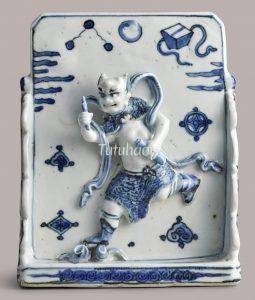God of Literature
魁星
© Tutuhaoyi.com owns the copyright of the description content for the images attached. Quoting all or part of the description content on this page is permitted ONLY IF ‘Tutuhaoyi.com’ is clearly acknowledged anywhere your quote is produced unless stated otherwise. (本页描述内容版权归Tutuhaoyi.com所有,转发或引用需注明 “Tutuhaoyi.com”, 侵权必究, 已注开源信息的条目除外。)
The term ‘Kui Xing’ originally referred to the North Star (北斗 Bei Dou). As stated in the Historical Records by Sima Qian (司马迁 145BCE – ?) , ‘Kui is the first star of the Great Dipper constellation’. Therefore, Kui also carries the meaning of being the first.
Gu Yanwu (顾炎武 1613–1682), a scholar in the late Ming and early Qing dynasties, wrote in his book ‘Records of Daily-Gained Knowledge’ (日知录 Rizhilu):
“The origin of the worship of Kui Xing by people today is unknown. Kui 奎 was the master of Literature, and therefore temples were built to worship him. However, he could not be portrayed accurately, and thus was changed to a homophonous name of ‘Kui 魁’. But even this was not easy to portrait Kui, so the character Kui 魁 was split into 鬼 (meaning ghost, demon or spirit) and 斗 dou (a vessel for measurement, also a pun for the Dipper Bei Dou) so that the image of Kui can be illustrated by a spirit lifting one foot and supporting a dou vessel.”
Legend has it that the writing brush he was holding was used to write the names of successful candidates in the imperial examinations. Once their names were written, their literary and official careers were guaranteed to flourish. Therefore, during the imperial examination era, scholars regarded Kui Xing as a deity of their great fortune.
Related Pun Picture:
You will certainly come out first in the imperial examinations 必定夺魁
Related Figural Scene:
Fig 1: gilded and lacquered bronze figure, Qing dynasty (1644–1911), courtesy of the Trustees of the British Museum
Fig 2: bronze figure, 1550-1640, courtesy of the Victoria & Albert Museum, London
Fig 3: porcelain table screen, 16th century, Ming dynasty, courtesy of the Sotheby’s Auction House, London, 4 Nov 2021, Lot 347


